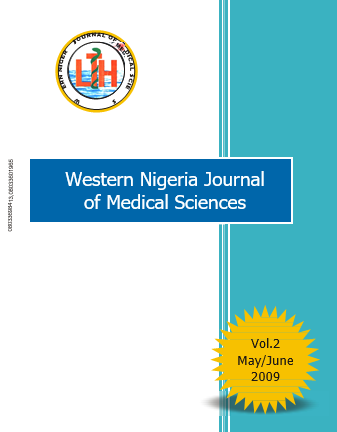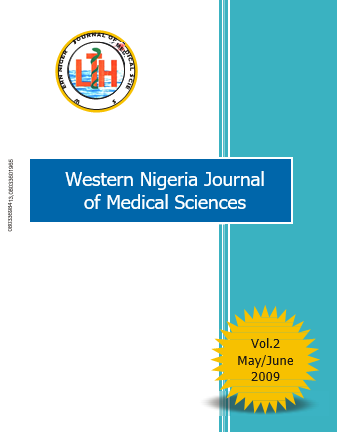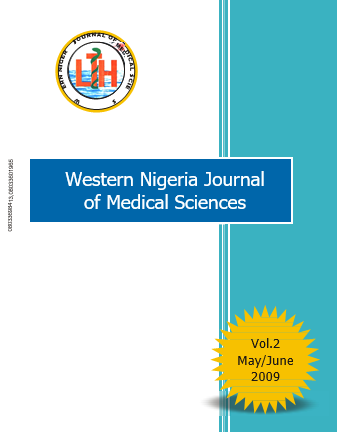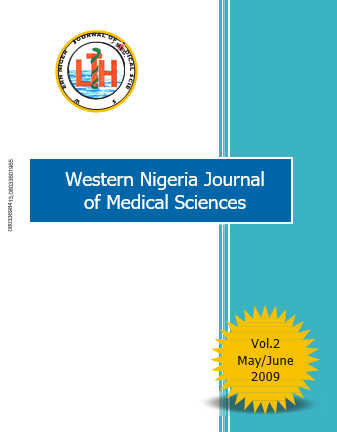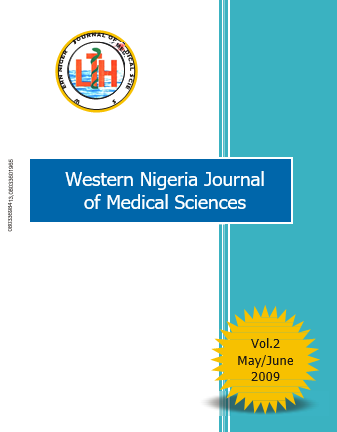Vol. 2 No. 02 May/June (2009): Western Nigeria Journal of Medical Sciences volume 2

TWO FRONT BURNERS ON THE AFRICAN MORBIDITY MORTALITY SCALE
The present issue of the Western Nigeria Journal of Medical Sciences contains a review article on The Human Immunodeficiency Virus (HIV) infection and an investigative paper on Home Management of Malaria. These are two preventable diseases that have remained scourged in many sub-Saharan African populations. Decades ago, malaria and HIV infections together with tuberculosis, measles, acute respiratory infections, and diarrhoeal disorders were classified by the G8 / G7 leaders in collaboration with WHO, and UNICEF. Etc as diseases of poverty and targeted for a massive effort.
Ezechi et al have written a review on the Prevention of Mother to Child Transmission of HIV infection. This is a subject of immense importance because the vast majority of childhood HIV infections take place via the mother-to-child vertical route plus the fact that HIV/AIDS burden in Nigeria is the third-largest in the entire world after India and South Africa. Estimates run into 2.86 million for the infected and 1.5million for cumulative deaths. It is obvious that the way to control HIV/AIDS in children is to prevent it in adults. Malaria is a persisting old problem. Since over two decades ago, it had been known to contribute 41% to total under-fives morbidity and 30% to total under-fives deaths in Nigeria. Even now the malaria situation has not improved much. 40% of the world population mostly in developing countries is at risk of malaria with 300 to 500 million yearly infections and an estimated 1- 2 million deaths. Ninety percent of malaria cases and deaths are among the under-fives children in Africa. The plans of WHO for global eradication have given way to the less definitive plans of campaigns and controls. In the meantime, vectors have developed resistance to insecticides and parasites to chemotherapeutic agents. The ROLL BACK MALARIA strategy initiated by WHO, UNICEF, UNDP, and the world bank in 1998 is a package comprising of focus on the highest risk group of mothers and children, preventive treatment of pregnant women, access to rapid diagnosis and treatment at village/community level , better use of existing control tools, interventions like integrated childhood illness management to reduce malaria deaths, improved surveillance and multiple prevention measures including insecticides bed nets and vector control. Double chemotherapy was introduced to combat the rising prevalence of resistance to drugs.
However, today, malaria remains a scourge in Nigeria and similar poor resource countries. The paper by Oyedeji et al on the home management of malaria shows some of the reasons why this is so. If we are able, somehow to combine prompt and correct home treatment of malaria with its preventive measures, we could achieve better control.
Unless we are able to turn policy at the governmental and the sponsoring health agencies levels to practice at the village/community and home levels, we can be accused of professing prevention very much but practicing it very little. Principally too, we must address the underlying poor socio-economic conditions which have turned HIV and malaria infections into diseases of poverty. After all, it has been stated that poverty of the spirit and of resources remains the antecedent risk factor for preventable disease. Of course, the future breakthrough to the discovery of effective and affordable vaccines for these infections is the real hope; but should the suffering and deaths continue while we wait for the vaccines?
Gabriel A. Oyedeji





